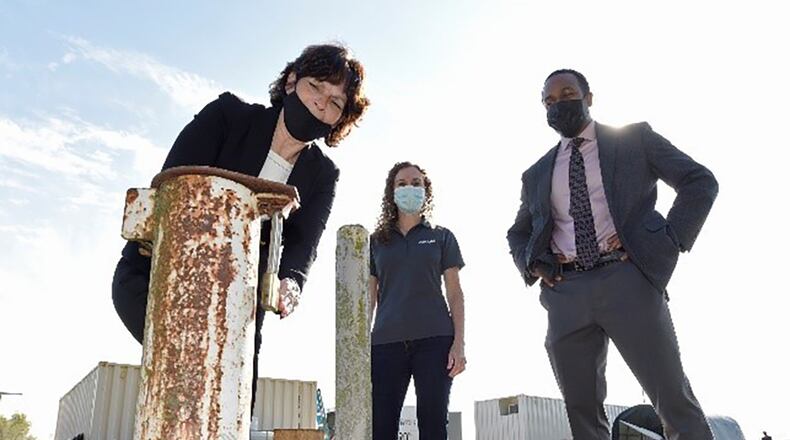The stability of PFAS compounds makes them difficult to destroy, especially after they inadvertently enter the environment. Out of the thousands of PFAS compounds, there is heightened regulatory concern over two in particular: PFOS and PFOA.
“It is great to be out here, seeing what the team has been working on,” he said. “There’s a lot of hard work that’s going into coupling existing technologies and new technologies to create a brand-new treatment train approach to help with the vast problem of destroying and getting rid of the PFAS that is prevalent.”
“The team is doing great work, and Wright-Patt was very happy to be a pilot base for these technologies,” Mott said. “Our contractor and AFCEC restoration teams are doing just a tremendous job, and we look forward to seeing how this is going to be scalable and help us overcome the challenges that we’re facing. Not only for here at Wright-Patt, but how it impacts our local community as well. Again, we’re just very happy with being a pilot base to field this technology approach.”
“We were very pleased that the Air Force supported the first-ever field demonstration of our on-site PFAS destruction technology DE-FLUOROTM,” said Rebecca Mora, AECOM project manager. “There were several things going on at the site in tandem to accomplish project objectives. First, ECT2′s established regenerable ion exchange resin technology, SORBIXTM RePURE, was used to separate PFAS from site groundwater. Once exhausted, the resin is regenerated for reuse, which includes a distillation process to produce a highly concentrated, low-volume PFAS waste referred to as still bottom. Our DE-FLUOROTM technology then destroys the concentrated PFAS in the still bottom using electrochemical oxidation. The overall treatment process has achieved non-detect levels of PFOS and PFOA in the treated groundwater discharge while the removed PFAS are concentrated and destroyed onsite.”
This pilot system has treated more than 500,000 gallons of PFAS-impacted groundwater at two sites at Wright-Patterson AFB.
Mora explained that AECOM teamed up with the University of Georgia to use a proprietary electrochemical oxidation process that destroys the PFAS contained in the SORBIX RePURE still bottoms.
The Air Force supported this first-ever field demonstration of electrochemical oxidation for on-site destruction of PFAS. It is also the first field demonstration that couples regenerable ion exchange resin with a PFAS destruction technology.
This treatment approach can remove contaminants from groundwater, thus protecting the on-base and off-base community. Additionally, other military installations where PFAS occur will benefit from the results of this pilot study.
xxxxxxxxxxxxx
Environmental protection
A pilot PFAS (poly-fluroalkyl substances) study took place at the Wright-Patterson Air Force Base’s Fire Training Center Sept. 29.
PFAS are “manufactured chemicals used in products that resist heat, oil, stains and water,” said Amir Mott, deputy director, 88th Civil Engineering Group, who was on hand to explain the importance of the study.
“There’s a lot of hard work that’s going into coupling existing technologies with new technologies to create a brand-new technology to help with the vast problem of destroying and getting rid of the PFAS that is prevalent,” Mott said.
He added, “The team is doing great work, and Wright-Patt was very happy to be a pilot base for these technologies, and our contractor teams, our restoration team, are doing just a tremendous job. We look forward to how this is going to be scalable and how it’s going to help us overcome the challenges that we’re facing. Not only for here at Wright-Patt but how it impacts our local community as well. So we’re just very happy with being a pilot base to field this technology.”
“There were several things going on at the site in tandem,” said Rebecca Mora, AECOM project manager. “The ECG two-system is an established commercialized technology, and it’s more of an innovative demonstration piece of the project.”
Mora explained that AECOM teamed up with the University of Georgia to use a particular electrode for electrochemical oxidation of PFAS – the mechanism that destroys the PFAS.
This technology can prove to remove contaminants from ground water, thus protecting the on-base and off-base community. Additionally, other military installations will benefit from the results of this pilot study.
About the Author
